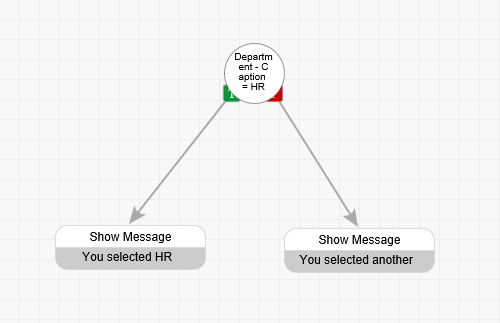
Conditional behaviors allow you to take specific actions based on some action or object in the app.
 |
Example: On a vacation request app, if a user requests normal leave, we want the app to skip to the page titled 'Normal'. If any other options (maternity, hospitalization or unpaid) are selected then the app should jump to the page titled 'Other'. |
Simple Branch
The Simple Branch command allows you to set a single condition that results in a true or false value. There is one line exiting the command, which represents the TRUE result. The join line then connects to further behavior commands. Optionally a second FALSE join line can exit the Simple Branch command, which can be attached to further commands. There cannot be more than two join lines exiting a Simple Branch command.

Multiple Branch
To perform app actions based on more than two conditions, use the Multiple Branch command. You can specify each condition by clicking on each join line exiting the command, and then specifying the condition on the Properties panel.

 |
As a general rule, the Multiple Branch Command will create more 'overhead' in the app than the Simple Branch Command and can slow down the loading and execution of the app if used excessively. Do not use Branch Commands unnecessarily. When they are required, use Simple Branch Commands wherever possible.
Branch commands using an 'Is Empty' condition recognize '0' as a value and would not consider such a field empty. |
See also: Connect Commands and Integration
Return to Adding Behaviors, Designing an App
